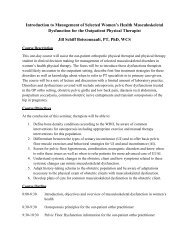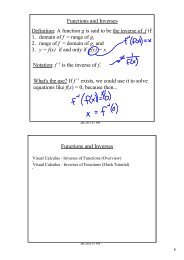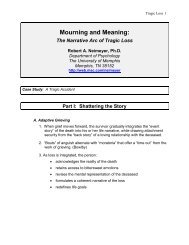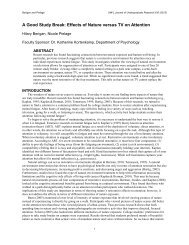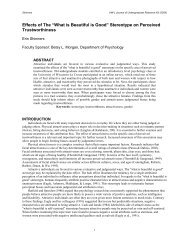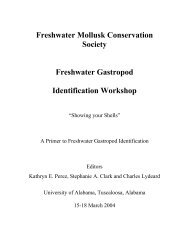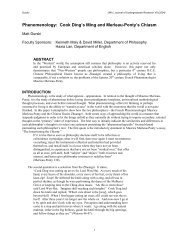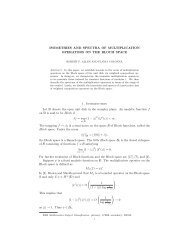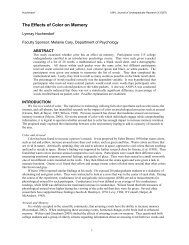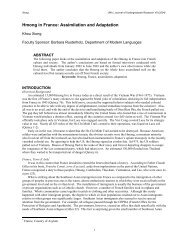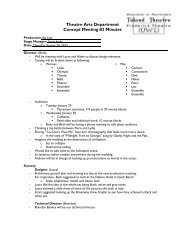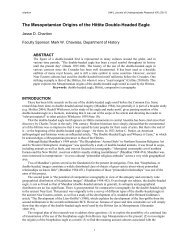Sister Sister: Interpreting Intimacy in Sibling Relationships
Sister Sister: Interpreting Intimacy in Sibling Relationships
Sister Sister: Interpreting Intimacy in Sibling Relationships
You also want an ePaper? Increase the reach of your titles
YUMPU automatically turns print PDFs into web optimized ePapers that Google loves.
Stach UW-L Journal of Undergraduate Research X (2007)<br />
<strong>Intimacy</strong> is a phenomenon that has not often been used <strong>in</strong> sibl<strong>in</strong>g research, however, has received a great deal of<br />
attention <strong>in</strong> recent literature (Prager, 2000). Mov<strong>in</strong>g this to the context of sisterhood, the researcher feels that while<br />
all sisters share some level of <strong>in</strong>timacy, the actual experience of <strong>in</strong>timacy between sisters is likely as unique as each<br />
pair of sisters. Therefore, the experience of <strong>in</strong>timacy can be used as a spr<strong>in</strong>gboard <strong>in</strong>to understand<strong>in</strong>g the<br />
relationship between two or more sisters. Us<strong>in</strong>g <strong>in</strong>timacy as a way to conceptualize sister relationships did not only<br />
provide orig<strong>in</strong>al research, but also made use of a flourish<strong>in</strong>g trend. In addition to this, the ways <strong>in</strong> which this<br />
<strong>in</strong>timacy was communicated was important because it showed the uniqueness of sister relationships.<br />
METHOD<br />
This study was qualitative <strong>in</strong> nature. Strauss and Corb<strong>in</strong> (1998) share that “Qualitative methods can be used to<br />
obta<strong>in</strong> the <strong>in</strong>tricate details about phenomena such as feel<strong>in</strong>gs, thought process, and emotions that are difficult to<br />
extract or learn about through conventional research methods” (p.11). Qualitative research was the best choice for<br />
this study because understand<strong>in</strong>g participants’ <strong>in</strong>ner feel<strong>in</strong>gs and thoughts about <strong>in</strong>timacy and family was imperative.<br />
This study was also <strong>in</strong>terpretive and an <strong>in</strong>ductive approach was used, as the observations came prior to formulation<br />
of a theory (Miller, 2002). This allowed for results to emerge from the data rather than enter<strong>in</strong>g the <strong>in</strong>terviews with a<br />
preconceived protocol of what the participants’ responses should <strong>in</strong>clude. Also assist<strong>in</strong>g <strong>in</strong> this study was the use of<br />
semi-structured <strong>in</strong>terviews to collect data. The researcher used these <strong>in</strong>terviews to ask primary questions while still<br />
allow<strong>in</strong>g room to probe when necessary and as was beneficial to each <strong>in</strong>dividual <strong>in</strong>terviewee (Frey, Botan, Friedman,<br />
& Kreps, 1993). The follow<strong>in</strong>g sections further expla<strong>in</strong> these methodologies that have been used <strong>in</strong> the presented<br />
research.<br />
Participants<br />
The participants for this study were females who have a sister with whom they are close to and were at least 18<br />
years of age at the time of the study. Participants <strong>in</strong>cluded n<strong>in</strong>e females with sisters rang<strong>in</strong>g from 18-60 <strong>in</strong> age, with<br />
<strong>in</strong>terviews ceas<strong>in</strong>g when data saturation was reached. Data saturation occurs when the researcher recognizes that<br />
while new stories are presented, the same themes are be<strong>in</strong>g repeated. Because the <strong>in</strong>terviewee was required to def<strong>in</strong>e<br />
her sister relationship as close or <strong>in</strong>timate, nonrandom sampl<strong>in</strong>g was used to choose participants. In fact,<br />
randomization is not a concern for <strong>in</strong>terpretive research s<strong>in</strong>ce there is no attempt to generalize. More specifically the<br />
researcher used the method of convenience sampl<strong>in</strong>g. Accord<strong>in</strong>g to Re<strong>in</strong>ard (2001), through convenience sampl<strong>in</strong>g,<br />
the researcher chooses participants based on who is most readily available to them. The researcher solicited<br />
volunteers from her network of friends and family to participate <strong>in</strong> the study.<br />
Interview<br />
The researcher used a developed <strong>in</strong>terview protocol, or a predeterm<strong>in</strong>ed set of questions, to guide the research,<br />
allow<strong>in</strong>g for prob<strong>in</strong>g questions and additional <strong>in</strong>formation as necessary (Frey, Botan, Friedman, & Kreps, 1993).<br />
The <strong>in</strong>terviews used a semi-structured format. In semi-structured <strong>in</strong>terviews, the <strong>in</strong>terviewer “establishes a general<br />
direction for the conversation and peruses specific topics,” allow<strong>in</strong>g participants to answer and expand on what is<br />
most important to them (Baxter & Babbie, 2004, p. 191). By us<strong>in</strong>g semi-structured <strong>in</strong>terviews, the researcher<br />
encouraged participants to disclose <strong>in</strong>formation about their relationship without supply<strong>in</strong>g them with ideas or preconceived<br />
assumptions about <strong>in</strong>timacy. This method of data collection also allowed for unique questions and<br />
prob<strong>in</strong>g that is uniquely relevant to each pair of sisters.<br />
Procedures<br />
The researcher <strong>in</strong>terviewed participants from her personal network of acqua<strong>in</strong>tances. The <strong>in</strong>terviews occurred <strong>in</strong><br />
either the home of the participant or home of the researcher, depend<strong>in</strong>g on availability and convenience. The<br />
researcher began the <strong>in</strong>terview<strong>in</strong>g process upon receiv<strong>in</strong>g IRB approval. Participants were first <strong>in</strong>formed of what<br />
will be discussed, the purpose, that there were no known risks, and the projected length (one half hour per <strong>in</strong>terview).<br />
They were each also <strong>in</strong>formed that the <strong>in</strong>terviews were to be tape-recorded and pseudonyms were to be used <strong>in</strong> the<br />
written portion of the report. Each participant then signed an <strong>in</strong>formed consent form before engag<strong>in</strong>g <strong>in</strong> the<br />
<strong>in</strong>terview. The <strong>in</strong>terviews lasted anywhere from 20-30 m<strong>in</strong>utes. Participants were given a gift certificate at the end<br />
of their <strong>in</strong>terview for their participation <strong>in</strong> this study. Questions were asked from the <strong>in</strong>terview protocol and prob<strong>in</strong>g<br />
questions often followed based on each <strong>in</strong>dividual participant’s answer. Time was also allowed for the participant to<br />
ask questions and/or comment at the end.<br />
4



